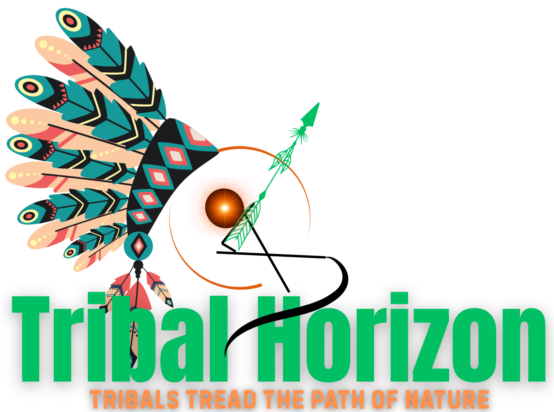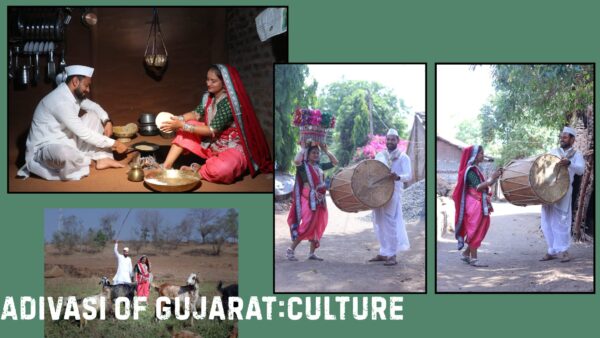Gujarat is home to many tribal (Adivasi) communities that keep their cultural identity and customs alive. These include groups like the Bhil sub-castes, Vasava, Rathwa, Gamit, Dungri Bhil, and Warli. They share their traditions through stories, festivals, and art while maintaining a close relationship with nature.
Their lifestyle shows respect for the land, water, and forests. Tribal folk dances, sacred rituals, and colourful Pithora paintings are important parts of Gujarat’s heritage. This article looks at their unique experiences, cultural practices, and contributions to society.
Major Adivasi Communities in Gujarat
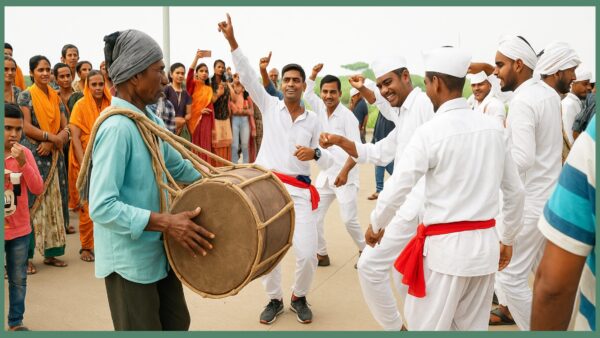
Today, we are diving into the vibrant tribal(Adivasi) life and culture of Gujarat. We will gain an in-depth understanding of the major tribal communities in the state, which proudly represent approximately 1.25 crore individuals. The governments of Gujarat and India officially recognise around 35 to 40 distinct tribal castes, highlighting the rich diversity of these communities. But today, we will know about the main ones and their inclusion in sub-castes.
When we look at different tribes in the world or in a country, we see that even though their customs, castes, and traditions may vary, they still share some common qualities. It is important to recognize these shared traits and to respect each other’s laws and traditions.
The vibrant tapestry of the 12 main Adivasis of Gujarat.
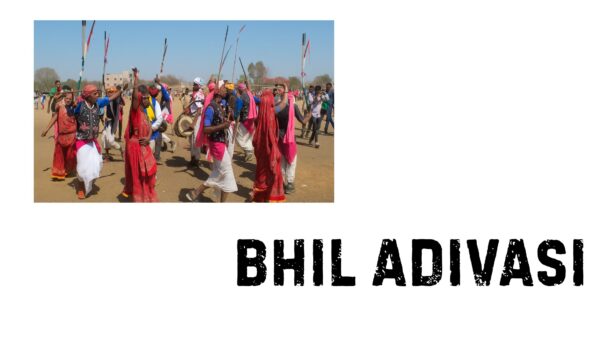
The Bhils are recognized as one of the significant tribes(Adivasi) in India, although their historical roots are not primarily found in Gujarat.
History indicates that Adivasi communities have existed since time immemorial, making them considered indigenous people. Tribals are believed to have originated thousands of years ago. When the Dravidian people arrived in India, they could not understand the Bhil dialect. However, the identity of the tribals is symbolized by the arrow, which they carried with them. It is believed that they descended from the Dravidian clan, linked to the word “Billu,” which means arrow.
The Bhils speak a dialect called ‘Bhilodi’ or ‘Bhili’. Their art is known as ‘Bharadi’. The Bhils are mentioned in various ancient Indian texts.Currently, Bhils live on the eastern border of Gujarat and in the Satpudan hills. Diwaliben Bhil and Sabarimata are the ancestors of the Bhil Adivasi in Gujarat.It is believed that the primary caste is the Bhil, from which all sub-castes and various tribes have emerged.The Bhil men confidently wear a loincloth, a shirt, and a gamcha on their heads, while the women proudly don elegant robes.
The Bhils celebrate many festivals, but Holi is regarded as the most important one. This festival holds special significance and conveys a message about nature. Additionally, it is used to predict the fate of the coming year.
Before the Aryans arrived, the Bhils ruled the land of India and wielded significant power. With the onset of conflicts among the Aryans, the Bhils firmly rejected slavery after their defeat and chose to retreat to the forests and mountains. Today, the tribal areas clearly reflect their presence, with Bhil communities established firmly in the mountainous and forested regions that surround them.There are sub-castes among the Bhils such as Dungri Bhil, Dungri Garasia, Bhil Garasia, Dholi Bhil, Rawal Bhil, Tadvi Bhil, Mevasi Bhil, Vasava, Dungarabhil, Vasave, and Pavara.
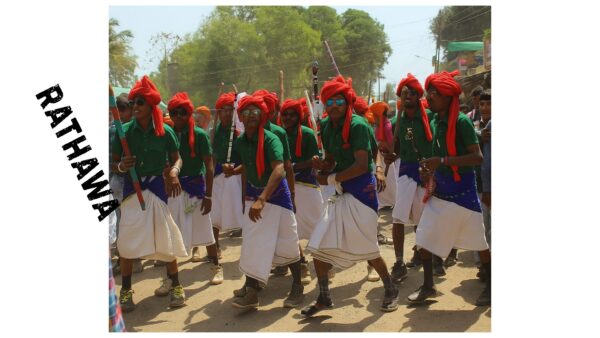
The Rathwa caste is one of the main tribes(Adivasi) in India, but its customs, traditions, and rituals are diverse and have distinct cultural characteristics in both social and religious contexts.The Rathwa tribe is originally from the state of Madhya Pradesh. The tribes of the Rathwa state are mainly in the Vadodara and Panchmahal districts of Gujarat. As a result of the settlement of the Rathwas in the north-eastern area of Chhota Udepur, the area is known as ‘Rath’ today.
When the list of tribals was prepared in Gujarat, the Rathwas, who identified themselves as Rathwa Koli, were deprived of the special benefits associated with being a tribal caste.In the past, all the residents identified themselves as ‘Koli.’ From this identity, they began to be known as ‘Bariya.’ Now that they have become aware of their original caste for the sake of government classification, they are returning to identify themselves as ‘Rathwa.’
The average height of Rathwa men ranges from 5 to 5.2 feet. They typically have round, wide heads with medium-length noses, and their eye colors vary between brown and black. The skin tones of Rathwa men are primarily brown or light. Traditionally, Rathwa men wear a “Copto,” which is a type of loincloth, along with a “Hajaria,” a piece worn on the head. However, due to increasing education and urban influence, many men now also wear “Khamish,” which refers to a shirt, along with trousers.
As for women’s clothing, the main attire consists of a “Chaniya,” which is paired with a cloth known as “khashad,” along with a cover called “lugdu.” For the Chaniya, a fabric called “nadada” is primarily used. The length of the nadada is around 26 inches, which is why Chaniyas are sewn vertically. The color of the nadada typically features a mix of dark green and black.
The types of Baba include Baba Ind, Black Desert God, Rani Kajal. While the Earth Goddess or God, Village Bagool God, Khatrij God, Dudhiya God, Godariya God, Seembodia God, Telav Mata, Hathani Mata, Holimata, Kanari Devi, etc. are the minor gods and goddesses.
“Holi” is a significant festival celebrated by the tribal Rathwas. It spans five days, beginning on the full moon of Phalgun and culminating on the fifth day. During this period, various locations host vibrant fairs to mark the occasion, emphasizing the cultural importance of this celebration.
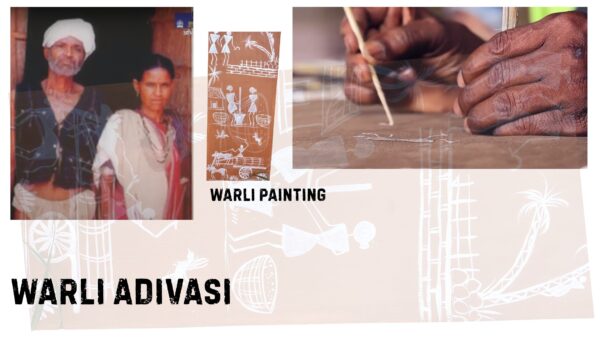
While tribal communities have often been seen as nomadic throughout history, the Warli Adivasi people stand as a testament to resilience. Never enslaved, they emerged with strength during the British-driven upheavals in the Deccan in the 14th and 15th centuries. Driven further by the imperial ambitions of the Marathas, these Adivasis bravely left the Konkan region to forge a new life in Dharampur, Surat, and the surrounding forested lands they now call home
The Warli tribe(Adivasi) exemplifies a profound respect for nature, setting themselves apart from other tribal communities. They practice sustainable agriculture, thoughtfully uprooting old forest trees to make space for new ones, thereby playing a crucial role in maintaining environmental balance. The name “Warli” originates from the Warli dialect, where small agricultural plots are referred to as “Warul.” This term not only describes these plots but also means “upland,” reflecting the tribe’s deep-rooted connection to their land.
History shows that the Warli Adivasi‘s have never enslaved anyone, and they reside in hilly regions. They prefer to live in their own communities, free from slavery, and aim to be in harmony with nature. Their original dialect is Konkani, which is somewhat related to Marathi and Bhili dialects. The Warli people in Gujarat speak the ‘Warli’ dialect.
The Warli tribe is renowned for its distinctive art form known as Warli painting, which is celebrated nationally. This unique pictorial language illustrates various aspects of life, such as dance, agriculture, and marriage. Warli paintings are created using white paint applied to a layer of raw clay, typically set against a background of rice paste and ochre.
The festivals and beliefs of the Warli tribe include the following: Hirwa festival, which is dedicated to trees; Diwasi, the worship of the forest god; and Malad festival, which is related to agriculture.
Men traditionally wear dhotis, headbands, and have bare chests, while women wear lungis or sari-styled clothes, often adorned with silver jewelry. However, in today’s modern era, these traditional attire have become less common as people have become more educated. If you observe some grandparents, their appearance is often associated with the colors of goodness and nature. Many young people from the Warli community move to cities for jobs, while their traditional art, Warli Painting, enjoys international popularity.
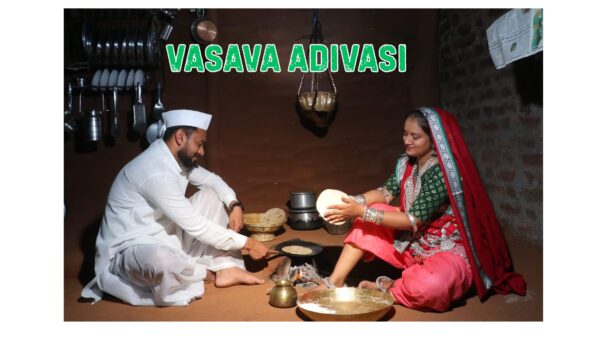
The Vasava Gamit is a well-defined sub-caste of the Bhils. They established their communities in villages, which is how they came to be known as “Gamit.” The Gamit, or Vasava, are also referred to as Gavit or Mavchi. Their primary occupation is agriculture, reflecting their strong connection to the land. A vibrant expression of their culture is the traditional dance known as Rodali, which is a beloved ritual among the Gamit/Vasava people.
The dialect spoken by the Vasava and Gamit Adivasi is known as the ‘Vasava Gamit’ dialect. While there are some differences in specific words, the overall dialect is quite similar, with no significant distinctions. However, variations can be found based on the region, such as in the Padvi and Valvi subgroups of the Vasava tribe. During an engagement, the groom’s relatives take him to the bride’s house, and afterward, the bride’s family visits the groom’s house. This practice is referred to as ‘gharjoni.’
The settled tribes migrated from Maharashtra and Rajasthan to the Dang, Tapi, Narmada, and Surat areas of Gujarat.Villages are primarily situated on the outskirts of forests or in hilly regions. The population is small, and these settlements are typically based on family or caste (Phalia).
The clothing of settled and rural tribes varies significantly. Men typically wear cotton dhotis, white shirts, and hats, while women often wear loincloths. Many individuals from settled and rural communities are increasingly pursuing education and job opportunities, so traditional attire like the parvesh is not always common. However, during wedding ceremonies, people frequently don the parvesh specific to their caste and adhere to traditional customs associated with their weddings.
However, social neglect and business difficulties persist in some areas, which is sad.
Holi is the most significant festival among their celebrations. However, other festivals such as Matla Dev, Vadha Dev, Fasli Parva, Kholu Punjan, and Chauri Amavasya are also observed. In this community, both the gods and the clan goddesses, Devamogra Mata and Devlimali Mata, are worshipped and honored with offerings.
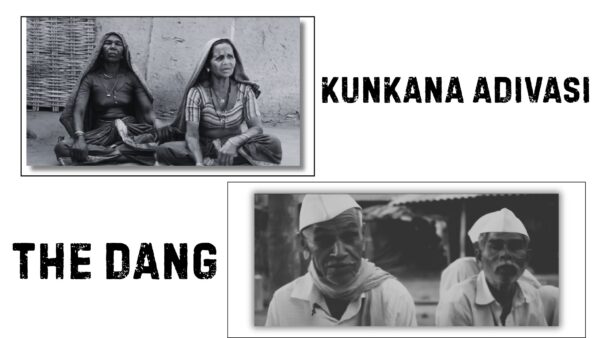
They are referred to as ‘Kunkana’ because they originate from the Konkan region.Like many tribal communities, the Kunkana tribe(Adivasi) resides in villages on the outskirts of the forest and maintains a lifestyle deeply connected to nature.The dialect spoken by the Kukana people is known as “Kukana”, “Konkani”, or “Kukana Bhili”. Traditionally, the Konkana dialect is primarily oral.
The Kukana people live in southern Gujarat and the Gujarat-Maharashtra border. They live mainly in villages in the mountainous and forested areas.The Kukana people inhabit the border area of South Gujarat and Maharashtra. They primarily reside in villages located in mountainous and forested regions, with a significant presence in Dang district. Additionally, Kukanas can also be found in Valsad, Navsari, and Tapi. In Surat, they are present in smaller numbers in the interior areas such as Mangrol and Mahuva, as well as in Namarda and Chhota Udepur.
The lives of the Kukana people are connected to nature, so they generally live in forested areas, mountainous areas, and coastal areas.
Holi is a vibrant festival celebrated by the Kukna people, along with many other tribal communities. The Kukna place a strong emphasis on Kani (grains), which they worship during Holi as they begin to enjoy the new harvest. Another important celebration is Chauri Amavasya, observed in Gujarat, where animals, especially bulls, are adorned in elaborate decorations. This festival is particularly significant for tribal farmers as it fosters a deep connection with the land and its cycles.
Kunkana tribal men traditionally wear a dhoti, which is typically white or earth-colored and made of cotton. Over their kameez, kurta, or shirt, they often wear simple cotton shirts or kurtas, especially during festivals or fairs. Some adult men also tie a “pheto,” or turban, on their heads, which is a symbol of their self-respect and tribal identity.
Kunkana women typically wear cotton, dark-colored loincloths that are plain and without designs. They often drape one end of the loincloth over their heads. The loincloths are worn with a blouse, which is usually sewn at home.
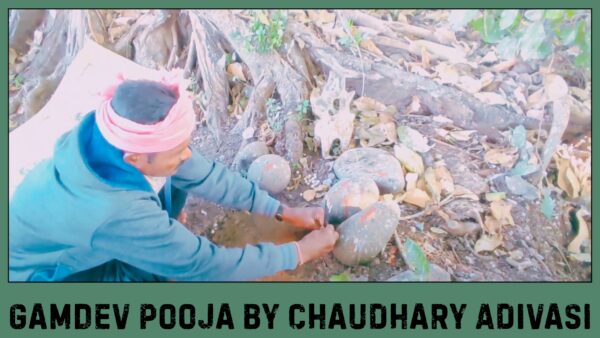
Among the Adivasi groups, we will now focus on the Chaudhary tribe. The Chaudhary people are believed to have originally come from Pavagadh. After the Muslim kings conquered Pavagadh, the tribals refused to accept slavery, which led the Chaudhary people to settle in the Surat, Tapi, Narmada, Valsad, and Bharuch districts of South Gujarat.
There are three sub-castes within the Chaudhary tribe: Pavagadhia, Valwai, and Takaria. They speak a dialect unique to the Chaudhary tribe, which varies slightly in different regions.
The term “Chaudhari” refers to a chief or elder man. Historically, they are thought to have been leaders or descendants of local rulers from earlier times. While they are present in Gujarat, Rajasthan, and Madhya Pradesh, they are most numerous in the districts of Valsad, Tapi, and Navsari in Gujarat.The area mainly relies on agriculture, producing crops like okra, yam, maize, and millet, even from poor land. Some people work as urban laborers or in government jobs.
The main deities include Kalika Mata, Gowal Dev, Gamdev, village Hanumanji, Bhuva Dev, village deity etc. A mixture of Brahminical rituals is seen with tribal rituals.The Chaudhary community considers itself distinct from the Bhils(Adivasi); they often refer to themselves as “unbhil”.Their social structure is highly structured, with village councils, male heads, and community leaders working together.
Men typically wear a dhoti, shirt, and sometimes a feto (turban). Women often wear plain sarees and cholis, colourful clothes, and homemade jewellery.You can see the GAMDEV worship here and you will understand.
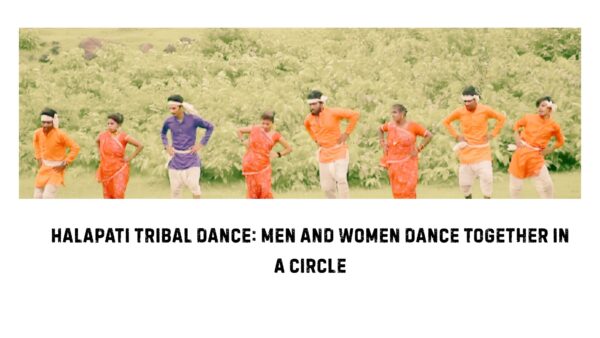
Among the tribal populations, the Halpati community has the largest numbers after the Bhils. This community is primarily located in the districts of Surat, Bharuch, Dang, and Vadodara.The Halpatis speak “Halpati,” a Gujarati dialect influenced by Bhil and Dangi.
The Halpati community consists of three sub-castes: 1. Talawiya 2. Vohariya 3. Kharja Members of this community have a Naat-Patel (panch) who assists in resolving the issues faced by the people.When societal problems arise, the village confronts them head-on, actively engaging in discussions about controversial issues. Together, we will find effective solutions and reclaim our community.
Earlier this community was addressed as Dubla but this word was insulting to the people,
Gandhiji gave this community the name ‘Halpati’.
The term “Halpati” originates from Sanskrit, where “Hal” means ploughing and “pati” means owner.The ancestors of the Halpatis worked as helpers for various communities in agriculture and water management, which is how they got their name. The ‘Gheraiya’ and ‘Hali’ dances of the Halpati people are well-known.
The Halpati Adivasi community boasts a rich heritage rooted in agricultural labour, fishing, and farming. Renowned for their exceptional fishing skills, Halpatis thrive along dams and riverbanks. In recent years, many members of this resilient community have successfully transitioned into urban professions, excelling in roles such as watchkeeping, small-scale entrepreneurship, and government jobs.
In Gujarat, tribal men wear a dhoti and shirt, and a feto (turban) for festivals. Women don simple sarees and cholis with silver ornaments. During festivals, men wear colorful clothing for dancing.
Just as Holi is the main festival in the tribal clan, Holi also has importance in the Halpati clan.The Halapati community has an organized religion and uses a group decision-making system. They depend on the forest for fuel, medicine, and fruits.
The origins of the Nayaka people among tribal groups are a bit of a mystery and still being researched. Some folks believe they might have come from northeastern India. In the Indian Constitution, they’re listed as a Scheduled Tribe. As an Adivasi community, the Nayaka have their own unique identity, which sets them apart from other tribal communities through their language, clothes, homes, and traditions.
This group, known as “Nayaka” or “Nayaka” in Sanskrit, has a significant role within Gujarat’s Adivasi landscape. They mainly reside in the southern and central parts of Gujarat, like Panchmahal, Dahod, Vadodara, Surat, and Narmada districts. In Surat and Valsad, people are called Nayaka, just like those in Panchmahal and Vadodara.
People in this caste speak the Nayaki dialect, which is a mix of Marathi and Gujarati. The primary language of the Nayaka community is Gujarati, along with the Nayaki dialect, which incorporates some elements of the Bhil language. Many people also understand Bhil and share cultural traits with the Bhil community. The subgroups of this community, known as Choliwala, include Nayak, Nayakada, and Kapadia Nayak.
The Nayaka community primarily relies on agriculture, labour, and forest products. They have extensive knowledge of medicinal plants, herbs, and traditional healing methods, which are passed down through generations. The Nayaka people are predominantly Hindus, but local deities play a larger role in their beliefs and worship. They worship the Kuldevi/goddesses, the Vandevi, the Pawandevi, ghosts, and ancestors.
Holi is a lively festival for the Nayaka community, featuring music, dance, and large gatherings. The popular “Ger Nritya” sees participants of all ages dancing with drums and cymbals.The Nayaka people celebrate Navratri with unique “Garba” and “Dandiya,” honoring Maa Amba with their own drums, distinct from city styles.
The people of this caste reside in the Kutch region and speak a dialect that is similar to Kutch. They are fond of hunting, which is why they are called ‘Parghi.’ The Parghis hold trees in great reverence, viewing them as their clan gods. They specifically worship trees such as Bor, Shami, and Mango. The leader of the Pardhi community is referred to as the ‘Nayak.’
The term “Pardhi” means “hunter.” Historically, the Pardhi caste has been recognised as primary hunters, living in forests and relying on nature for their livelihood. However, they have often been seen as separate from other communities. During the British colonial era, they were unfairly labelled as a criminal caste under the Criminal Tribes Act of 1871, leading to ongoing social discrimination. Despite these challenges, the Pardhi community remains committed to preserving its cultural identity.
The Pardhi are a tribal community that speaks Gujarati, Marathi, and sometimes Hindi. Their culture features traditional attire, with men in dhotis and topis and women in colorful saris. Notable subcastes include Phaspardhi, Gayapardhi, Takaripardhi, and Chitaripardhi.
Pardhi people practice Hinduism, worshiping deities like Kalika Mata and Hanumanji, as well as their ancestors and family goddess.
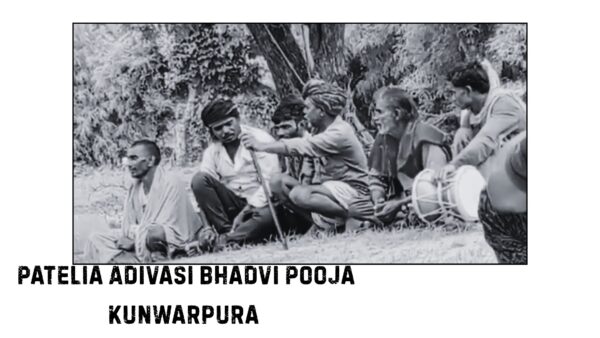
The term “Patelia” originates from the word “Patel,” which translates to “chief person. Historians suggest that the Patelia community, initially identifying as “Patel,” later became known as “Patelia” among the Bhils Adivasi.”This tribal community is similar to the Rathwa tribal community. The people of this caste mainly live in the Panchmahal district.
The Patelia people primarily speak Bhili, along with Gujarati and Hindi, and have a deep appreciation for folk dance, music, and stories. During festivals, they joyfully perform dances like Gavavi, Dola, and Garba. Their folk songs eloquently express themes of nature, love, and heroism.
The Patelia community worships Hindu, tribal, and folk deities, including Kalika Mata, Devamogra, Khodiyar Mata, and Mahadeva.
The Patelia society operates under a patriarchal system with a male head. The marriage system is based on caste, and social norms are adhered to strictly.In today’s Pateliya society, issues such as neglect of education, health problems, and lack of employment have emerged. However, the new generation is becoming more educated and is also moving towards urban living.
The Patelia caste exemplifies the tribal identity of Gujarat and Rajasthan.
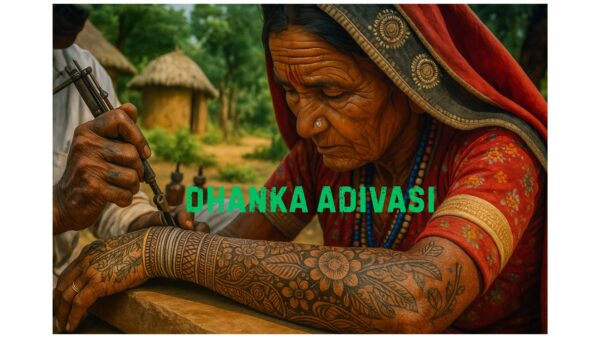
The people of this tribe(Adivasi) are called ‘Dhanaka’ as they live on light grains. Their main occupation is agriculture, collection of forest produce and casual labour. There are two subcastes of this caste: Tadvi, Tetaria. They were called ‘Tadvi’ because they lived on the banks of the Narmada and Tapi. The exact origin of the word “Dhanaka” remains uncertain; however, it is widely thought by historians to be traditionally associated with the Bhils and other tribal communities. This connection highlights the rich cultural heritage and diverse history of these groups, inviting further exploration and study.
The Dhanka adivasi community is prominently established in several districts of Gujarat, including Dahod, Panchmahal, Mahisagar, Vadodara, Chota Udepur, Navsari, Surat, and Valsad.The Dhanka tribe speaks Gujarati and, in some areas, local languages like Bhili and Maghi.
The Dhanka community once focused on hunting, farming, and gathering forest produce. Today, their main occupations are farming, agricultural labor, domestic work, menial tasks, and small-scale industries in some areas. Many are small-scale farmers or support their families through daily labor.
The Dhanaka adivasi people actively follow Hinduism, worshipping various deities such as Kalika Mata, Mogal Mata, Khodiyar, Hanumanji, and Mahadeva. They celebrate key festivals like Holi, Navratri, and Diwali, while also honouring their own clan deities.
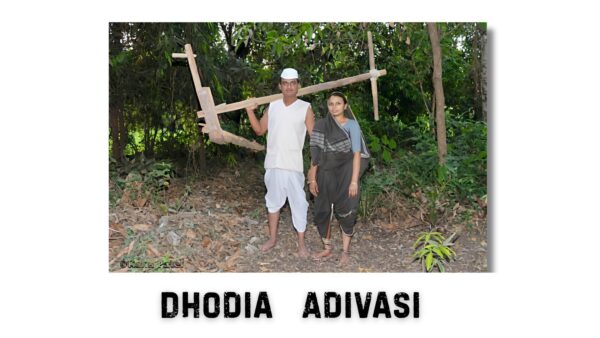
The term “Dhodia” is believed to have originated from the word “Dhod,” which translates to mountains or elevated terrain. The Dhodia community has historically been established in the Ghat region, where their way of life has been intricately connected to the natural resources available in their environment.
The Dang district is home to residents from the surrounding areas. In response to natural disasters and recurrent droughts, many individuals from this community migrated to Gujarat. They communicate in the ‘Dhodia’ dialect, which exhibits influences from the Marathi language.
Historically, the primary occupations of the Dhodia people have included: Rainfed agriculture, cultivating crops such as maize, tur, bajra, and nachni Agricultural labor Gathering wood, herbs, and honey from forested areas Animal husbandry In recent years, an increasing number of individuals are advancing in their pursuits of employment, entrepreneurship, and education.
The Dhodia Adivasi people are Hindus who worship Mughal Mata, Khodiyar Mata, Mahadeva/Shivaji, Hanumanji, and local and clan deities, integrating folk and tribal beliefs. Men: dhoti, tunic, and top. Women: colourful saree, blouse, ghagra, necklace, and silver jewellery.
What does the term “Adivasi” mean?
The word “Adivasi” literally means “native inhabitants”. A group of people who have lived since time immemorial, traditionally living close to nature and following unique cultural and social practices.
In which parts of Gujarat do Adivasi people mostly live?
Adivasi communities in Gujarat primarily live in the southern and eastern regions, including Dahod, Chhota Udepur, Narmada, Valsad, Dang, Tapi, Surat, Panchmahal, and Mahisagar, which are mostly forested and hilly.
Do tribal people speak their own dialect?
Yes, Adivasis are definitely from before the emergence of language, so they speak their own dialect, which has no script. Bhil, Rathi, Chaudhary, Vasava, Gamit, Dangi, etc.
Are Gujarat’s Adivasi communities adopting modern lifestyles?
Adivasi youth are pursuing higher education and jobs in cities, but still stay connected to their traditions and festivals.
Are all Adivasi communities considered Scheduled Tribes (ST)?
“Adivasi” refers to Scheduled Tribes (ST) in India, which are entitled to special rights and protections.
Conclusion
The Adivasi communities of Gujarat stand as the original guardians of the land, forests, and rivers. As indigenous Adivasi tribes, they embody a rich Indian identity, showcasing diverse traditions, unique dialects, and distinctive caste customs. These communities possess an impressive depth of knowledge regarding the laws of nature. From the Bhil Adivasis in eastern Gujarat to the Dhodia Adivasis in the south, every caste carries a heritage that is both ancient and continuously evolving, underscoring their vital role in the region’s cultural tapestry.
In today’s changing society, many youth from the tribes of Gujarat are adopting modern education and employment opportunities while still valuing their ancestral traditions, forests, festivals, and folklore. Recognising and respecting the identity of the tribes of Gujarat is vital not only for the progress of these communities but also for the preservation of India’s rich cultural diversity.
Tribal Horizons is vital for documenting and raising awareness of indigenous communities, honouring Gujarat’s roots and ensuring their voices are celebrated for future generations. in free to share your feedback. If you have any issues or any kind of questions, you can comment below. Thnak u…..
